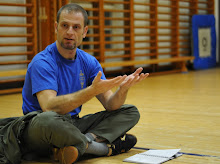 "A person reacts to stress by breathing in shallow patterns using chest muscles. The habit carries to times even when not stressed and erodes into times of sleep. [...] When excess CO2 is exhaled, blood becomes too alcaline, leading to vasoconstriction, which causes a feeling of apprehension. The breathing pattern worsens and alkalization leads to increasingly sensitive nerve endings until pain can occur even during tasks, which were once pain free. Overused muscles (once postural but now used for breathing) retain acid wastes becoming stiff and fatigue easily as they are used for non-productive energy even during sleep. Spinal joints stiffen as they fail to move properly during breathing. The person seeks more rest and less movement. [...] Finally sleep deprivation then brings about mood and cognitive changes. This quickly becomes a case of physiology overwhelming psychology. By the time shallow breathers are seen in clinics, it may appear that the psychology is overwhelming the physiology and such patients are labeled psychosomatic".
"A person reacts to stress by breathing in shallow patterns using chest muscles. The habit carries to times even when not stressed and erodes into times of sleep. [...] When excess CO2 is exhaled, blood becomes too alcaline, leading to vasoconstriction, which causes a feeling of apprehension. The breathing pattern worsens and alkalization leads to increasingly sensitive nerve endings until pain can occur even during tasks, which were once pain free. Overused muscles (once postural but now used for breathing) retain acid wastes becoming stiff and fatigue easily as they are used for non-productive energy even during sleep. Spinal joints stiffen as they fail to move properly during breathing. The person seeks more rest and less movement. [...] Finally sleep deprivation then brings about mood and cognitive changes. This quickly becomes a case of physiology overwhelming psychology. By the time shallow breathers are seen in clinics, it may appear that the psychology is overwhelming the physiology and such patients are labeled psychosomatic".Colangelo, Joy. Embodied Wisdom : What our anatomy can teach us about the art of living. iUniverse, 2003, p. 112-113
"...Diaphragmatic breathing, with the belly expanding to the front and sides during inhalation [...] has the following effects on cardiac function:

- decreased heart rate
- decreased cardiac output
- reduced peripheral systolic blood pressure
- regulation of the cardiovascular system by parasympathetic functions of the autonomic nervous system
- regulation of the heartbeat by the ebb and flow of respiratory sinus arrhythmia.
Hanna, Thomas. Somatics. Da Capo Press, 1988, p. xiii
 "For those who prefer the 'certainty' of physiological science, it may help to understand the localization of the olfactory system in our central nervous system. Over the course of evolution our have enlarged like a city that grows progressively. There is the historical part: the antique city that embraces the oldest quarters, which in our brain is the 'reptile' or 'primitive' part - the palocortex. Then, there is the new districts of the city, or the neocortex. The most sensitive nerve endings that cover the area of the olfactory receptors are in direct contact with the 'old city', or with the part of the brain that is the seat of instinct, inherited from our most distant ancestors. With reflexive mechanisms [i.e. breathing exercises] we touch the 'visceral brain' and therefore organs such as the heart, blood vessels, bladder, intestine and gall bladder. Through other connections we also influence the pituary gland and the hypothalamus that both lie in the primitive brain; in this way we stimulate, through the use of hormones, the whole endocrine system - the 'chemical nervous system'".
"For those who prefer the 'certainty' of physiological science, it may help to understand the localization of the olfactory system in our central nervous system. Over the course of evolution our have enlarged like a city that grows progressively. There is the historical part: the antique city that embraces the oldest quarters, which in our brain is the 'reptile' or 'primitive' part - the palocortex. Then, there is the new districts of the city, or the neocortex. The most sensitive nerve endings that cover the area of the olfactory receptors are in direct contact with the 'old city', or with the part of the brain that is the seat of instinct, inherited from our most distant ancestors. With reflexive mechanisms [i.e. breathing exercises] we touch the 'visceral brain' and therefore organs such as the heart, blood vessels, bladder, intestine and gall bladder. Through other connections we also influence the pituary gland and the hypothalamus that both lie in the primitive brain; in this way we stimulate, through the use of hormones, the whole endocrine system - the 'chemical nervous system'".Pelizzari, U., Tovaglieri, S. Manual of Freediving: Underwater on a Single Breath. Idelson Gnocchi, 2004, p. 114







No comments:
Post a Comment